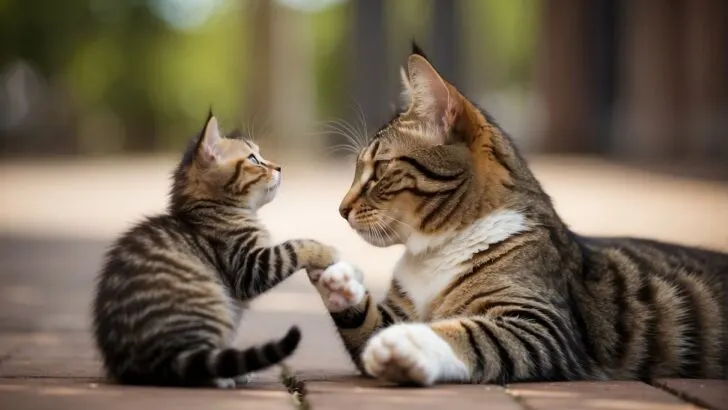Mother cats indeed engage in play with their kittens, which is essential both for bonding and for teaching the young cats about the world around them.
You’ll often notice how a mother cat initiates a game of chase or mock combat, using these playful interactions to teach her kittens vital survival skills such as hunting, pouncing, and how to interpret behavior. It’s not just about fun; it’s a critical part of feline development.

When you watch a mother cat with her litter, you might be charmed to see her using a toy to play fetch, or perhaps you’ll catch her gently swatting a kitten to encourage a playful response.
These activities help kittens develop their coordination and start to understand social cues within the cat community. As a cat owner, you might have witnessed these tender yet educational moments and recognized how such interactions help kittens learn boundaries and develop healthy relationships.
Observing these playful exchanges can give you insight into the nurturing aspects of cat behavior that go beyond basic care. It’s moments like when a mother gently grooms her kitten after a play session that show how these interactions reinforce their bonds.
Mother Cat and Kitten Dynamics

When observing mother cats with their kittens, the deliberate interactions and play sessions are more than just endearing moments; they’re crucial for kitten development and social structure.
Importance of Play in Kitten Development
Mother cats, or queens, actively engage in playtime with their kittens to teach vital life skills. These playful interactions encourage development of hunting skills through behaviors such as chasing and wrestling.
Your kittens not only learn to coordinate their movements but also improve their physical strength and socialization skills by playing with littermates and their mother.
Mother Cats Teaching and Nurturing
The behavior of mother cats is multifaceted, combining nurturing with teaching. From nursing to weaning, queens constantly guide their kittens. She teaches bite inhibition and uses behavior modification techniques to discipline, ensuring her kittens grow up with the manners and skills needed to thrive as adult cats.
Grooming is part of this teaching process, as well as a way to establish cleanliness and comfort.
Establishing Trust and Bonds Through Play
Playtime is a golden opportunity for mother cats to strengthen their bond with their kittens, establishing a sense of trustand attachment. These playful interactions are more than just entertainment; they are the foundations of a trusting relationship, allowing kittens to feel safe and secure in their environment.
Interactions Between Kittens, Mother Cats, and Humans
For pet parents, understanding and respecting the natural interactions between mother cats and their offspring is essential.
Encouraging and supporting this bond, while introducing human handling in a gentle and gradual way, helps to socialize kittens. Correcting kittens is primarily the job of the queen, but as they grow, human interaction plays a significant role in further socializing and preparing kittens for life in a household.
Is it Normal for Cats to Play Rough with Their Kittens?
When observing the interactions between mother cats and their offspring, one might wonder about the nature of their physical play. It’s important to recognize that rough play is a normal part of feline behavior, serving as a way for kittens to learn important life skills.
Recognizing Playing vs Fighting
Encountering your kittens pouncing, stalking, and engaging in what appears to be aggressive behavior can initially be alarming. However, playtime between kittens and their mother is not only expected but beneficial. Here’s how you can distinguish play from fighting:
- Sounds: Playful interactions are usually silent. If you hear hissing, growling, or loud meowing, it may be a sign of actual aggression.
- Body Language: Look for relaxed postures and movements. During play, claws are typically retracted, and bites are controlled so as not to cause harm.
- Reciprocity: Play fighting is a give-and-take; you’ll see the roles of chaser and chased switch frequently among playing cats.
- Ending: Play usually winds down with both parties disengaging peacefully, while real fights may end with one cat retreating with fear or aggression.
It’s fascinating to watch how mother cats set boundaries during these interactions, teaching their kittens limits. If one kitten is too rough, the mother cat or the other kittens may signal it’s too much by stopping the play abruptly.
Remember, as a cat owner, it’s important to monitor their play but also to let kittens learn these vital communication skills naturally.

My name is James, and welcome to FAQCats!
Along with our team of cat owners, expert pet enthusiasts, and pet professionals, we aim to write engaging helpful, engaging content about cats. At FAQCats we strive to provide content that’s accurate and fun to read. Our team writes about everything related to cats; even the most complex of topics. Through extensive research and caring for our own fur-pals, we’re able to provide something cat owners worldwide will love. Have a look around, and leave us feedback anytime!

